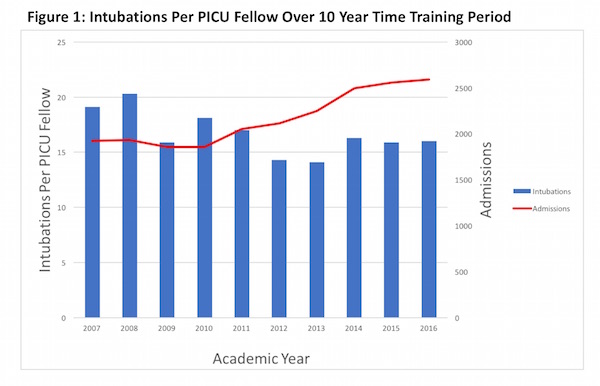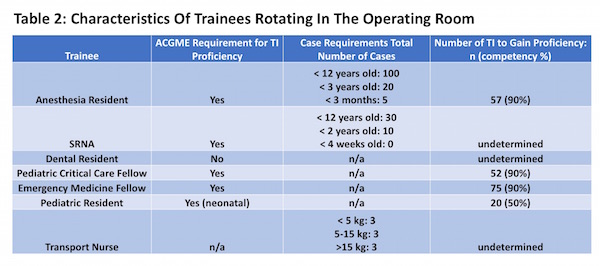NM-227
Trainees Learning Tracheal Intubation In The Pediatric Operating Room
Engorn B, Margolis R, Scott G, Newth C, Ross P
Children's Hospital Los Angeles, Los Angeles, CA, USA
INTRODUCTION
Tracheal intubations (TI) outside of the operating room (OR) are associated with adverse events. The training level and type of provider is associated with outcomes (1-3). While the ACGME sets standards for TI, studies demonstrate varying numbers of TI before a learner exhibits competence (4-6). The OR offers a learning environment for trainees to acquire TI skills. The primary aim of this study was to provide a descriptive analysis of TI performed at a tertiary, academic, children’s hospital. The secondary aim was to investigate the educational needs of rotators to identify best practices.
METHODS
After IRB approval we reviewed 67,033 pediatric anesthetics at our institution from July 2014-June 2017. We identified 28,037 TI and characterized them by provider category, age, weight, and ASA classification. Differences between demographic data groups were determined using Kruskal-Wallis ANOVA by ranks and differences in ASA classification using expected versus observed Chi-Square. We reviewed the literature for educational requirements and number of TI for competency for rotating trainees. Finally, we analyzed TI performed by PICU fellows outside of the OR over 10 years to assess for adequacy of experience.
RESULTS
A descriptive analysis of TI performed is in Table 1. In a large number of cases the attending performs the TI and fellows perform the TI in most of the youngest patients. A review of trainee requirements for TI proficiency, anesthesia case requirements, and the literature for competency of TI is demonstrated in Table 2. Figure 1 shows a decline in annual out of OR intubations per PICU fellow despite an increase in admissions/year.
DISCUSSION
Anesthesia trainees gain adequate experience with TI; however, most of their cases involve older children. While it is imperative to balance safety and education, a number of TI performed by attendings, fellows, and CRNAs could be redistributed to trainees. PICU fellows are experiencing a decline in TI possibly due to non-invasive positive pressure modalities.
CONCLUSIONS
To help support colleagues, a systematic approach could be used to design learning opportunities for both anesthesia and non-anesthesia trainees in the OR.
REFERENCES
1 Nishisaki CCM 2013
2 Sanders Pediatrics 2013
3 Kerrey Annals of EM 2012
4 Je EM Journal 2015
5 Konrad A&A 1998
6 Ishizuka PCCM 2016
Top














